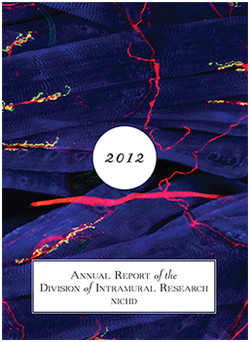Research on the Lifespan, Research for a Lifetime

With 11 research programs, more than 75 researchers, and more than 1,100 support staff, the NICHD's DIR is among the largest at the NIH. But with good reason—The NICHD's DIR also has one of the broadest research portfolios at the NIH, covering nearly all aspects of human development and reproduction.
The recently released 2012 DIR Annual Report highlights the activities and significant discoveries of DIR researchers and programs and the science that continues to improve the lives of infants, children, women, and families.
"2012 was a very productive year for the DIR," said Constantine A. Stratakis, M.D., D(med)Sci, Scientific Director of the NICHD and Director of DIR. "It was a time not only to look forward, through the NICHD's Scientific Vision and the Blue Ribbon Panel charged with examining all facets of the DIR, but also to examine—and celebrate—our past, as the Institute commemorated its 50th anniversary."
Dr. Stratakis sets the tone for the Report with his Director's Preface. After a listing of the membership of the Board of Scientific Counselors and brief descriptions of the annual activities of different DIR Offices, the Report summarizes the scientific activities and accomplishments of the various Sections and Units within the Division's research Programs. Highlights of these accomplishments include:
- Advances in the use of photoactivatable fluorescent proteins to investigate biological processes at the molecular level (Cell Biology and Metabolism Program)
- The characterization of a human X-linked intellectual disability syndrome caused by a genetic mutation that impairs protein binding (Program in Cellular Regulation and Metabolism)
- Findings that some of the same genes that promote body growth early in life are not only overexpressed in an embryonic cancer, but also contribute to abnormal growth of malignant cells (Program in Developmental Endocrinology and Genetics)
- Documentation of the critical role of a specific protein in normal cognitive function (Program in Developmental Neuroscience)
- Efforts to understand the role of non-coding RNAs in establishing chromosomal structures (Program in Genomics of Differentiation)
- Advances related to Menkes disease and iron metabolism diseases (Molecular Medicine Program)
- Development of a noninvasive technique for measuring the local changes in the cerebral hemodynamic levels associated with brain activity (Program on Pediatric Imaging and Tissue Sciences)
- Findings on cortisol physiology and pathophysiology and on ways to further characterize and treat malignant pheochromocytoma (Program in Reproductive and Adult Endocrinology)
- Development of a human brain-cell culture system, and its use in a newly invented device that aims to determine the cellular and pharmacological mechanisms of blast-induced traumatic brain injury (Program in Physical Biology)
- Development of novel approaches and algorithms that facilitate the prenatal diagnosis of congenital heart disease (Program in Perinatal Research and Obstetrics)
The Report also includes descriptions of research conducted by other DIR components, such as those within the Office of the Scientific Director. Notable accomplishments in the Report include the identification of new target for potential treatment of osteogenesis imperfecta using a mouse model (Bone and Extracellular Matrix Branch), and expanded understanding of the molecular mechanisms involved with converting short-term memory into long-term memory (Section on Nervous System Development and Plasticity).
DIR activities go well beyond the confines of the laboratory. For example, conducting clinical trials is a critical part of the DIR portfolio. The Office of the Clinical Director section of the Report notes 108 DIR protocols within five main areas: adult, pediatric, and reproductive endocrinology; human genetics; normal growth and development; national/international public heaflth; and women's health. These include studies of childhood obesity, endometriosis and pain, genetic disorders, and cognitive development, to name just a few.
In addition, the DIR supported more than 300 postbaccalaureate, clinical, and postdoctoral fellows and graduate students to further their academic and professional development. The DIR Office of Education leads these activities by recruiting and developing academic support programs and providing mentoring, evaluation, and career guidance. The DIR also maintains a number of high-quality, accredited, clinical training programs in pediatric and reproductive endocrinology, maternal-fetal medicine, genetics, and infertility.
Learn more about the scientific accomplishments of the NICHD's DIR by exploring the 2012 DIR Annual Report.
Originally Posted: May 22, 2013

 BACK TO TOP
BACK TO TOP